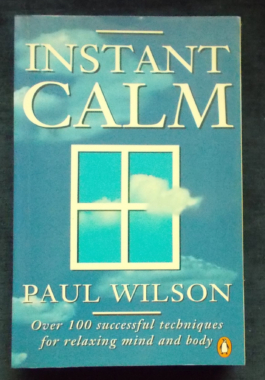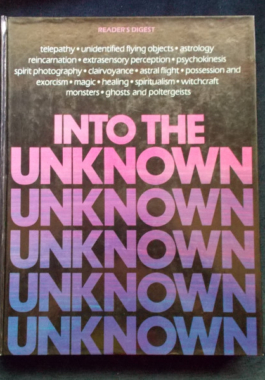-
 Instant Calm - the busy person's guide to finding peace and contentment in a restless world. These ingenious shortcuts to calm are written in entertaining, easy-to-follow language and are gleaned from sources as divergent as the wisdom of ancient civilizations and the discoveries of modern science. Wilson's solutions are based on meditation, acupressure, self-hypnosis, psychotherapy, aromatherapy, exercise, diet, and much more.
Instant Calm - the busy person's guide to finding peace and contentment in a restless world. These ingenious shortcuts to calm are written in entertaining, easy-to-follow language and are gleaned from sources as divergent as the wisdom of ancient civilizations and the discoveries of modern science. Wilson's solutions are based on meditation, acupressure, self-hypnosis, psychotherapy, aromatherapy, exercise, diet, and much more. -
 A fabulous volume of the paranormal and fascinating from the ancient past to the modern day. Chapters: Riddles of The Past; Ancient Monuments; The Search For Atlantis; The Art Of Magic; Witchcraft; Monsters; Divination; Astrology Reincarnation; Ghosts And Spirits; Spiritualism; PSI And Science; The Power Of Dreams; Animal PSI; Mind Over Matter; Leaving The Body; Healing; Enigmas In The Sky; PSI And The Brain. Lavish colour and black and white illustrations.
A fabulous volume of the paranormal and fascinating from the ancient past to the modern day. Chapters: Riddles of The Past; Ancient Monuments; The Search For Atlantis; The Art Of Magic; Witchcraft; Monsters; Divination; Astrology Reincarnation; Ghosts And Spirits; Spiritualism; PSI And Science; The Power Of Dreams; Animal PSI; Mind Over Matter; Leaving The Body; Healing; Enigmas In The Sky; PSI And The Brain. Lavish colour and black and white illustrations. -

A Literal Translation of the First Chapter of Jaimini's Upadesa Sutras. Apparently, Jaimini gave step-by-step instructions but secreted them into coded Sanskrit, with the result that every technique and principle founded in his Sutras are practised and translated differently by different astrologers. Here, for the first time, is the Sutra-by-Sutra, word by word rendition of Jaimini's Upadesa Sutras, revelaing many secrets of Jaimini with a complete chapter devoted to the instruction of how to interpret Jaimini's coded Sutras.
-

Just For Today: James Keller
$20.00How would life be if everyone on the face of the planet started the day with a strong, positive thought? Although this little book of a year of daily thoughts is Christian - complete with Bible references - the thoughts can be adapted to any faith. -
 DID YOU KNOW.... that in the Shetland Isles it is considered good luck to encounter a deformed or retarded person when going fishing? Or that the Ancient Hebrews believed that the ashes of a black kitten would enable one to see demons? Even the famous have their own beliefs and rituals: Luciano Pavarotti always looked for a bent nail on stage before he felt secure about singing an opera. On the luck front, Ranulf Flambard was unfortunate enough to be the first prisoner of the Tower of London - but as he was the builder and the architect of the Tower, he knew a secret way out and escaped. To ensure good luck, don't bring holly into the house before Christmas Eve and that in America it's unlucky to kill a toad, as these creatures were regarded by the indigenous Americans to be benevolent water-brings. A book that is so much more than unlucky broken mirrors and walking under ladders.
DID YOU KNOW.... that in the Shetland Isles it is considered good luck to encounter a deformed or retarded person when going fishing? Or that the Ancient Hebrews believed that the ashes of a black kitten would enable one to see demons? Even the famous have their own beliefs and rituals: Luciano Pavarotti always looked for a bent nail on stage before he felt secure about singing an opera. On the luck front, Ranulf Flambard was unfortunate enough to be the first prisoner of the Tower of London - but as he was the builder and the architect of the Tower, he knew a secret way out and escaped. To ensure good luck, don't bring holly into the house before Christmas Eve and that in America it's unlucky to kill a toad, as these creatures were regarded by the indigenous Americans to be benevolent water-brings. A book that is so much more than unlucky broken mirrors and walking under ladders. -

Eleven men embarked upon a journey in 1894 with one objective: to find the great spiritual teachers of the Far East and witness their uncommon abilities. Since these Masters were scattered over a wide territory that covered a large portion of India, Tibet, China and Persia, they knew it could take years of searching many secluded villages and hidden mountain communes. Planning each step of the journey became a challenge knowing that countless miles of rugged terrain separated the remote and isolate locations that were imperative to the exploration. Even though they could plot their route on a map and see where they were headed, the destination deep within the souls of eleven scientifically trained men remained uncertain. Baird T. Spalding and the others were practical in nature and the thought of spiritual masters performing miracles seemed impossible. Despite these suspect thoughts, something compelled them to move onward. So they did. Volume 1 covers the introduction of the Master Emil the visit to the "Temple of Silence"; astral projection; walking on Water a visit to the Healing Temple; the Snowmen of the Himalayas and sheds new light on the teachings of Jesus.
-
 Sagar asks: How are we - as a species living what we think is a civilised life - to survive? How do we continue to live in an overcrowded world whose finite resources are being rapidly exhausted and whose biological support systems are close to breakdown? There is a wide-spread and fast-growing belief that tinkering with economics and local conservation measures are not enough; that what is needed is a revolution in our consciousness regarding our place in the natural world and our responsibilities towards it. Science and religion are often referred to - but very rarely is there any mention of literature. Sagar attempts to reassert the essential relationship between imagination, nature and human survival. By close readings of major works by seventeen of the greatest writers (from Homer to Hughes) that literature has a central contribution to make in our efforts to discover the laws of nature and human nature, and to live within them.
Sagar asks: How are we - as a species living what we think is a civilised life - to survive? How do we continue to live in an overcrowded world whose finite resources are being rapidly exhausted and whose biological support systems are close to breakdown? There is a wide-spread and fast-growing belief that tinkering with economics and local conservation measures are not enough; that what is needed is a revolution in our consciousness regarding our place in the natural world and our responsibilities towards it. Science and religion are often referred to - but very rarely is there any mention of literature. Sagar attempts to reassert the essential relationship between imagination, nature and human survival. By close readings of major works by seventeen of the greatest writers (from Homer to Hughes) that literature has a central contribution to make in our efforts to discover the laws of nature and human nature, and to live within them. -
 Faith, a young orphan girl is adopted by a Christian couple, but her adoptive mother dies and her father's mother moves in to take care of the family. Grandmother is lazy, drunk and violent, insisting that her son be rid of Faith, resenting her as an outsider and an intruder. Faith runs away, determined to find work as a servant girl...and she begins to find friends and help where she least expects it. Also published as The CHild Of The Toy Stall.
Faith, a young orphan girl is adopted by a Christian couple, but her adoptive mother dies and her father's mother moves in to take care of the family. Grandmother is lazy, drunk and violent, insisting that her son be rid of Faith, resenting her as an outsider and an intruder. Faith runs away, determined to find work as a servant girl...and she begins to find friends and help where she least expects it. Also published as The CHild Of The Toy Stall.




